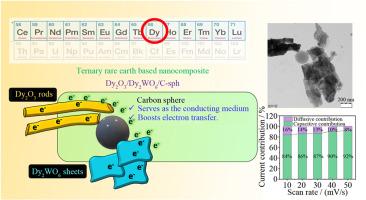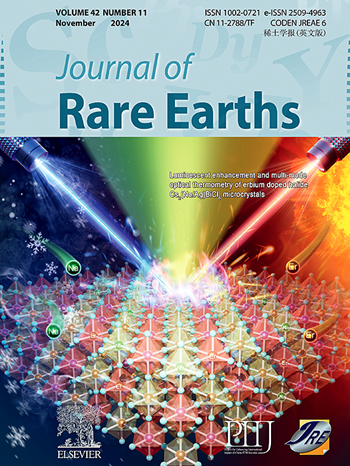Construction of ternary structured Dy2O3 nanorods/carbon spheres/few layered Dy2WO6 nanohybrids for electrochemical supercapacitors
IF 7.2
1区 化学
Q1 CHEMISTRY, APPLIED
引用次数: 0
Abstract
In this work, Dy2O3 rods and layered Dy2WO6 heterostructure were effectively interconnected by carbon spheres named Dy2O3/Dy2WO6/C-sph nanocomposite with a confined interface and it was fabricated using a simple solvothermal approach. These ternary nanocomposites were investigated by X-ray diffraction (XRD), UV–visible diffuse-reflectance spectroscopy (UV-DRS), Fourier transform-infrared spectroscopy (FT-IR), Raman, field emission scanning electron microscopy (FESEM) with energy disperse spectroscopy (EDS), high-resolution transmission electron microscopy (HRTEM), and X-ray photoelectron spectroscopy (XPS) analyses systematically. The XRD data expose that the synthesized materials are formed with a virtuous crystalline state. The charge storage properties and electrochemical performances of the as-synthesized nanocomposites and pure components were assessed with the help of cyclic voltammogram (CV), galvanostatic charge–discharge studies (GCD), and electrochemical impedance studies (EIS), respectively. The rare-earth-based novel Dy2O3/Dy2WO6/C-sph nanocomposite as working electrodes established commendable electrochemical performances with a maximum specific capacitance value of 123 F/g at a current density of 0.4 A/g in 2.0 mol/L aqueous KOH solution. According to the stability measurements, it was observed that the initial capacitance was maintained at ∼93% even after 2500 cycles, indicating that good electrochemical stability with the lowest internal resistance values was obtained from EIS analysis. The electrochemical measurements suggest that the Dy2O3/Dy2WO6/C-sph nanocomposite enables great competence and can be used as alternative electrode material in supercapacitor devices to avail high energy efficiency in a sustainable approach.

电化学超级电容器用三元结构Dy2O3纳米棒/碳球/多层Dy2WO6纳米杂化物的构建
在这项工作中,Dy2O3棒和层状Dy2WO6异质结构被称为Dy2O3/Dy2WO6/C-sph纳米复合材料的碳球有效地连接在一起,具有限制界面,并使用简单的溶剂热方法制备。采用x射线衍射(XRD)、紫外-可见漫反射光谱(UV-DRS)、傅里叶变换红外光谱(FT-IR)、拉曼光谱、场发射扫描电子显微镜(FESEM)和能量分散光谱(EDS)、高分辨率透射电子显微镜(HRTEM)和x射线光电子能谱(XPS)等方法对这些三元纳米复合材料进行了系统的研究。XRD数据表明,合成材料具有良好的结晶状态。利用循环伏安图(CV)、恒流充放电研究(GCD)和电化学阻抗研究(EIS)对合成的纳米复合材料和纯组分的电荷存储性能和电化学性能进行了评价。稀土基新型Dy2O3/Dy2WO6/C-sph纳米复合材料作为工作电极,在2.0 mol/L KOH水溶液中,电流密度为0.4 a /g时,最大比电容值为123 F/g,具有良好的电化学性能。根据稳定性测量,即使在2500次循环后,初始电容仍保持在~ 93%,这表明EIS分析获得了具有最低内阻值的良好电化学稳定性。电化学测量表明,Dy2O3/Dy2WO6/C-sph纳米复合材料具有很强的性能,可以作为超级电容器器件的替代电极材料,以可持续的方式实现高能效。
本文章由计算机程序翻译,如有差异,请以英文原文为准。
求助全文
约1分钟内获得全文
求助全文
来源期刊

Journal of Rare Earths
化学-应用化学
CiteScore
8.70
自引率
14.30%
发文量
374
审稿时长
1.7 months
期刊介绍:
The Journal of Rare Earths reports studies on the 17 rare earth elements. It is a unique English-language learned journal that publishes works on various aspects of basic theory and applied science in the field of rare earths (RE). The journal accepts original high-quality original research papers and review articles with inventive content, and complete experimental data. It represents high academic standards and new progress in the RE field. Due to the advantage of abundant RE resources of China, the research on RE develops very actively, and papers on the latest progress in this field emerge every year. It is not only an important resource in which technicians publish and obtain their latest research results on RE, but also an important way of reflecting the updated progress in RE research field.
The Journal of Rare Earths covers all research and application of RE rare earths including spectroscopy, luminescence and phosphors, rare earth catalysis, magnetism and magnetic materials, advanced rare earth materials, RE chemistry & hydrometallurgy, RE metallography & pyrometallurgy, RE new materials, RE solid state physics & solid state chemistry, rare earth applications, RE analysis & test, RE geology & ore dressing, etc.
 求助内容:
求助内容: 应助结果提醒方式:
应助结果提醒方式:


